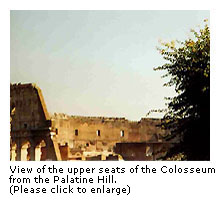Origines
 The
highlight followed in the afternoon with the gladiator fights
which were opened with the pompa (entering the arena).
The lictores (officials) marched up front, carrying
their fasces (bundle of rods with an axe as symbol
of their authority), followed by the musicians who also accompanied
the fights with music. After that, stretchers with statues
of deities (fercula) were brought into the arena; then
the dignitaries came in, finally followed by the gladiators
whose weapons were carried before them so that the audience
could see them unobstructed. The gladiators greeted the Emperor
or the editor, but never with the sentence "morituri
te salutant". This is recorded to have been said by noxii
(condemned) before Emperor Claudius. After that, the gladiators
competed in pairs. Sometimes more than one pair could be in
the arena at the same time. The pairings were drawn at the
beginning of the event. The
highlight followed in the afternoon with the gladiator fights
which were opened with the pompa (entering the arena).
The lictores (officials) marched up front, carrying
their fasces (bundle of rods with an axe as symbol
of their authority), followed by the musicians who also accompanied
the fights with music. After that, stretchers with statues
of deities (fercula) were brought into the arena; then
the dignitaries came in, finally followed by the gladiators
whose weapons were carried before them so that the audience
could see them unobstructed. The gladiators greeted the Emperor
or the editor, but never with the sentence "morituri
te salutant". This is recorded to have been said by noxii
(condemned) before Emperor Claudius. After that, the gladiators
competed in pairs. Sometimes more than one pair could be in
the arena at the same time. The pairings were drawn at the
beginning of the event.
At smaller events all gladiators came from the same ludus
(gladiator school), only at larger events gladiators from
several schools would appear. Therefore, in most cases one
had to fight his own comrade. Maybe this was one reason why
the defeated gladiator kept his helmet on when he expected
the coup de grâce from his opponent. Otherwise the winner
might have had constraints to face his comrade. A duel could
end in four different ways:
1. Death of one of the two combatants by a lethal wound received
during the fight.
2. Surrender of one of the two fighters by putting down his
shield and raising his left hand with stretched out index
finger plus the editor's decision of death after the audience
yelled "iugula" ("stab him"). The loser
had to kneel down and offer his throat in order to receive
the coup de grâce. Was he so badly wounded and hence
too weak for this gesture, he was turned onto his belly. Then
the winner stabbed him between the shoulder blades into the
heart.
|
